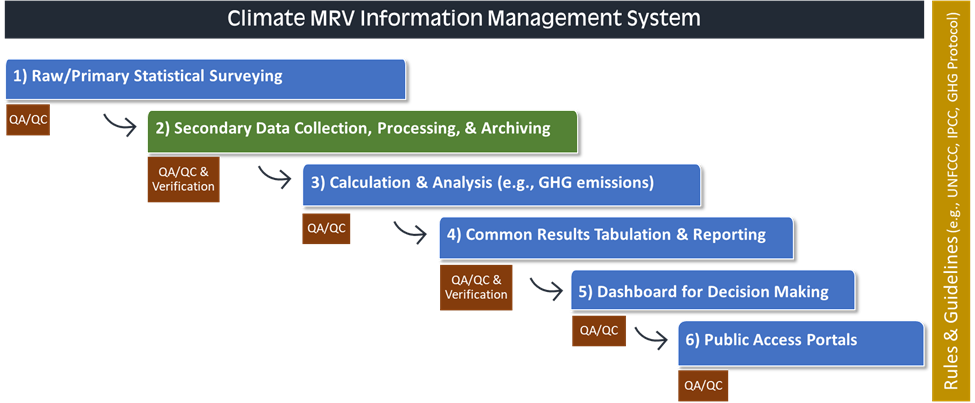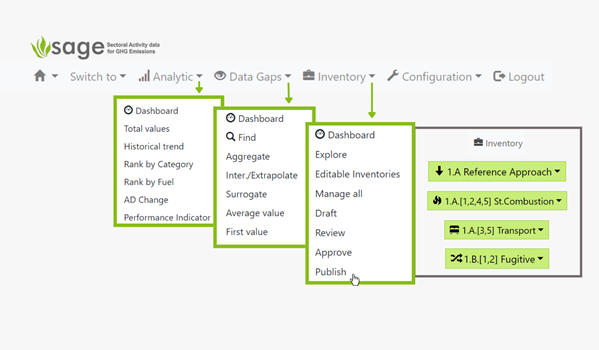The Sectoral Activity data for GHG Emissions (SAGE) tool provides a first-of-its-kind user-friendly interface for gathering and processing activity data in conjunction with documentation for greenhouse gas emissions inventories, projections, and mitigation impact analyses.
We know that reliable reporting by each country on their greenhouse gas (GHG) emissions and actions to reduce them is at the heart of the Paris Agreement. More broadly, the quality and transparency of these progress metrics are fundamental to both the effective design and implementation of each country’s domestic GHG mitigation and adaptation policies and tracking of Nationally Determined Contributions (NDCs).
Yet, we know that most countries are still far from reaching the reporting quality requirements laid out by the UN’s Framework Convention on Climate Change (UNFCCC) and, specifically, the Paris Agreement’s Enhanced Transparency Framework (ETF). A key reason for this gap in reporting is the absence of a data management tool to support countries to meet these requirements. In particular, tool #2 in the below figure.

All countries, and especially developing countries, are presently constructing and expanding their national data management infrastructure to track and report their climate actions and progress. The deadline for countries to submit their first compliance reports under the Paris Agreement is 31 December 2024. Yet too many countries are spending the time and resources available to fulfill this reporting requirement by building data management tools from scratch, and in some instances with little guidance, to construct climate measurement, reporting, and verification (MRV) systems.
This is unnecessary because software tools exist to help countries calculate GHG emissions (e.g., IPCC guidelines software) and model GHG mitigation scenarios (e.g., LEAP) (step #3 in the figure). All countries have some form of national statistical data system and tools for gathering primary statistical data on variables such as last year’s quantity of petrol imported or their population of dairy cattle on farms (step #1 in the figure). But there is a large and critical step for which no data management tool exists. This is the step of collecting, processing, cleaning, documenting, and archiving the numerous (e.g., hundreds), at times messy, and incredibly diverse statistical datasets addressing all emission sources and sinks across the entire economy to prepare national GHG inventories, projections, and mitigation analyses (step #2 in the figure). In addition, for many GHG inventory categories, countries can have trouble providing the data for the entire time series, and thus, data gaps appear. The lack of tools that support filling in these data gaps, and using the methodologies provided by IPCC, is another issue associated with collecting activity data time series for GHG calculations.
Existing GHG calculation and analysis tools use, as inputs, activity data that are assumed to be readily available and in a standard and precise format. But, in practice, it is well known that no country has a national statistical system that produces primary data in these exact formats. Appropriately formatted and usable activity data is instrumental to produce transparent GHG inventories and associated reports, as well as to improve national MRV systems. At present, national GHG emissions inventory compilers and mitigation analysts must construct ad-hoc methods and tools (e.g., spreadsheets) to “process” their typically messy and raw statistical data into the complete and clean secondary data required by existing emissions calculation, projection, and reporting tools.
In response to this prolonged deficiency, the Greenhouse Gas Management Institute is developing a data collection and management tool for countries—the Sectoral Activity data for GHG Emissions (SAGE) tool.[1] SAGE provides a first-of-its-kind, user-friendly interface for gathering and processing national activity data and outputs indispensable supporting documentation for GHG inventories, projections, and mitigation impact quantification. SAGE also steers users through the difficult work of identifying and filling in their data gaps and conducting data quality control checks, all in line with Intergovernmental Panel on Climate Change (IPCC) good practice.
SAGE does not replace other tools for estimating GHG emissions or removals, but rather provides a tool that supports the use of other tools by producing “clean” input data. The clean data SAGE produces can be used in the estimation of emissions by the IPCC inventory software and other major mitigation models and tools. But what specific problems does SAGE solve for countries?
- It makes the collection of secondary activity data from primary data suppliers easier by providing a secure portal for each data supplier to enter/upload their datasets (e.g., data collected from government and statistical agencies, industry associations, companies).
- Prompts and requires data suppliers and inventory compilers to provide sufficient documentation on their data gathering methods, references, data quality, and contact information for repeating the process in subsequent reporting cycles.
- It makes it quick and easy to select appropriate default parameters to characterize activity data[2] (e.g., fuel caloric values and densities appropriate to the country’s national circumstances).
- It converts each uploaded activity dataset into the proper format and units as needed by your chosen emissions calculation or modeling tool.
- It reduces the risk of accidental loss, omission of data, and human error that are a leading cause of poor-quality GHG emissions analyses by:
- Automating data quality control checks, including flagging problematic input data and time series;
- Identifying data gaps and providing user friendly and “smart” gap-filling applications;
- Archiving and backing up all data to preserve historical data, prevent the loss of institutional memory, and allow for the easy retrieval of data and documentation from previous foreign consultants;
- Supporting internal data quality review and customizable approval workflows for software users and their stakeholders;
- Ensuring that every addition and change to a country’s data is logged, auditable, and recoverable;
- It provides data security with different user access levels and administrative records of log-ins.
- It keeps your datasets confidential on a secure intranet of your choice or on the cloud while providing simultaneous and remote access to multiple users and data suppliers anytime, anywhere.
- It provides computer platform-independent access (e.g., it can work under Windows, Apple, UNIX, and other major existing operating systems), and can be run on mobile phone and tablet devices.
In hindsight, we sometimes realize that a fundamental task that we have long been doing the grueling manual way could be radically altered by the innovation of a new tool that does it better and with less effort. Such will be the hindsight realization with SAGE and derivative tools like it for other aspects of climate MRV.
Click here to sign up to be kept updated on news about SAGE.[1] Initially, SAGE has been developed to cover the most emissions-intensive sector: Energy. Work is ongoing to expand SAGE to cover all non-AFOLU sectors and agriculture. [2] SAGE is pre-populated with default values from 2006 IPCC Guidelines, such as uncertainty and fuel characteristic parameters.


Comments